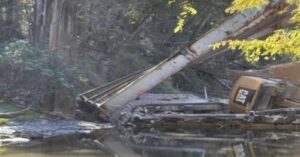A tragic bridge collapse in Simpson County, Mississippi, on Wednesday has resulted in the deaths of three individuals and injuries to at least four others. The incident, which occurred during ongoing construction work, has sent shockwaves through the local community and prompted questions regarding the safety of infrastructure in the area.
According to the Mississippi Department of Transportation (MDOT), the collapse happened on the Strong River Bridge along State Route 149. The bridge had been closed to traffic since September 18, as part of a major bridge replacement project. The construction company, T.L. Wallace, was in the process of demolishing the existing structure when it suddenly gave way, leading to the devastating loss of life and injuries on-site.

One of the victims tragically killed in the collapse was identified as Charlie Igleharte. The confirmation came from his sister, who spoke with local news outlet Channel 2 NOW. Igleharte’s death has sent ripples of grief through the community, with friends and neighbors mourning the loss of a man described as hardworking and devoted to his family. Details regarding the other two fatalities have yet to be released, as authorities continue their investigation into the incident.
A second individual, Aidan Lowery, was seriously injured during the collapse. Lowery was also working on the construction project when the bridge gave way. Fortunately, reports confirm that Lowery is in stable condition and is expected to recover from his injuries. His survival has been a source of relief to his family, but the trauma of the event is certain to leave a lasting impact.

The bridge project, intended to replace the old structure that had become unsafe over the years, was overseen by MDOT. An inspector from MDOT was on-site at the time of the collapse but was unharmed, according to officials. This presence raises questions about the safety protocols in place at the time and whether any warning signs of structural failure were detected before the collapse.
MDOT has extended its deepest condolences to the families of the victims. In an official statement, the department expressed shock and sadness over the tragic event, acknowledging the gravity of the situation and promising a full investigation into the causes of the collapse. “Our hearts go out to the families who have lost loved ones, and we will be working closely with local authorities to determine what went wrong,” an MDOT spokesperson said.
Simpson County residents are grappling with the tragedy, especially given the relatively quiet and close-knit nature of the community. Alisha Camper, a local resident, described the incident as “very sad,” emphasizing the rarity of such catastrophic events in the area. The collapse has left a profound impact on the community, raising concerns about infrastructure safety and the effectiveness of safety measures during major construction projects.
As investigations continue, experts will be looking at various factors that could have contributed to the bridge’s failure. These include the condition of the bridge prior to demolition, the methods employed by the construction team, and whether all safety protocols were followed. The National Transportation Safety Board (NTSB) and the Occupational Safety and Health Administration (OSHA) may also become involved, especially given the scale of the tragedy.
Bridge collapses are rare but not unheard of in the United States, with infrastructure being a major focus of concern in recent years. According to the American Society of Civil Engineers, nearly 42% of the nation’s bridges are over 50 years old, and 7.5% are considered structurally deficient. This has sparked national conversations about the urgent need for infrastructure repair and replacement across the country, especially in rural areas like Simpson County where resources for large-scale projects may be limited.
For the residents of Simpson County, the immediate concern is for the families who have lost loved ones and for those still recovering from their injuries. The collapse has left a lasting mark on the community, a stark reminder of the potential dangers present in such projects. The families affected by this tragedy will need time to heal as authorities work to ensure that nothing like this happens again.
This incident will likely fuel discussions around safety regulations in construction, the state of America’s aging infrastructure, and the responsibilities of contractors and oversight bodies in preventing such disasters. As the investigation unfolds, more details will emerge about what went wrong on that fateful day, and what can be done to avoid future tragedies.
